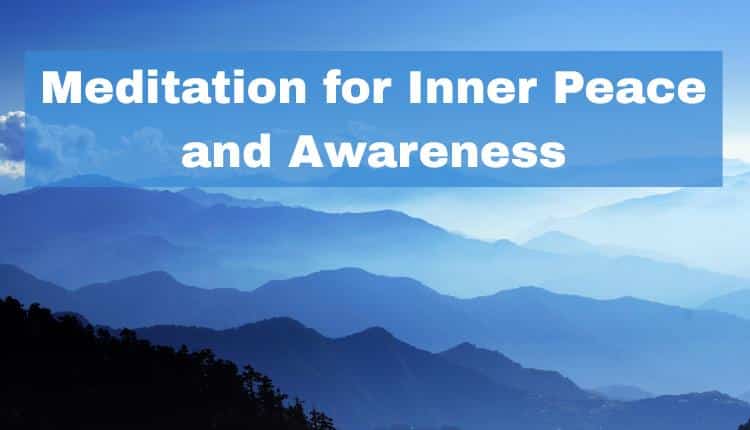
Meditation is more than just a practice—it is a way of life. Rooted in ancient traditions and validated by modern science, meditation is the key to mastering your thoughts, cultivating inner calm, and awakening deeper awareness.
Whether you seek stress relief, spiritual connection, or clarity of mind, meditation can guide you there.
Table of Contents
- What Is Meditation?
- Benefits of Meditation
- Different Types of Meditation
- How to Meditate: Step-by-Step Guide
- Common Obstacles in Meditation (And How to Overcome Them)
- How Long Should You Meditate?
- Meditation and Spiritual Awakening
- Advanced Meditation Practices
- FAQs About Meditation
- Recommended Articles
- Final Words
What Is Meditation?
Browse our online courses on meditation, positive thinking, overcoming procrastination, confidence, and freedom from distractions.
Meditation is the practice of focused attention and mental stillness. It involves training the mind to become quiet, clear, and aware.
While meditation takes many forms across cultures—from silent sitting to chanting mantras—its essence lies in turning inward, observing the mind, and connecting with a deeper reality.
Meditation is a practice of quieting the mind, turning inward, and developing deep inner awareness. It is not merely about relaxation or stress relief—though these are welcome byproducts—but about awakening to a higher dimension of consciousness.
The Essence of Meditation
At its essence, meditation is the art of becoming still, observing thoughts without judgment, and connecting with the deeper self beyond the mind and senses. It’s a sacred pause from the chaos of the outer world, where one learns to simply be.
Through meditation, the attention is withdrawn from the constant stream of thoughts and external distractions and is gently directed inward. This inward turning allows you to witness your inner world—the thoughts, emotions, desires, and fears—with clarity and detachment.
Over time, this practice cultivates mental silence, emotional balance, and a profound sense of presence. You begin to experience life not just through thought, but through direct, unfiltered awareness.
More than a technique, meditation is a state of being—calm, conscious, and awake. It opens the door to self-discovery, healing, and spiritual realization.
As layers of mental noise dissolve, what remains is the quiet presence of the true self.
Whether practiced for focus, peace, insight, or spiritual growth, meditation is a timeless key to unlocking the vast potential within.
Meditation Is Not Just Relaxation
Though often confused with relaxation, meditation is more than a stress-relief method. It is a conscious process of developing mental clarity, spiritual insight, and inner discipline. The aim is not to zone out but to become fully present and aware.
Many people approach meditation with the idea that it is simply a way to relax or reduce stress. While it does help the body unwind and calm the nervous system, this is only the surface level of what meditation truly offers.
Relaxation is a natural byproduct of meditation
Relaxation is a natural byproduct of meditation, but not its primary goal. The deeper purpose of meditation is to awaken consciousness, train the mind to become still, and connect with the essence of who you are. It’s not about escaping discomfort or zoning out—it’s about becoming fully present, alert, and aware of your inner world.
True meditation involves discipline, observation, and deep inner work. Unlike relaxation, which can be passive, meditation requires active awareness and continuous effort to bring the mind back to focus each time it drifts.
It sharpens perception, strengthens mental clarity, and allows you to step beyond the habitual noise of thoughts.
While relaxation soothes the surface, meditation transforms from the inside out—awakening intuition, dissolving inner tensions, and leading to lasting peace and self-realization.
Benefits of Meditation
Meditation brings countless benefits for the body, mind, and soul. Here are some of the most powerful ones:
- Calms the mind: Reduces mental chatter and overthinking.
- Improves concentration: Sharpens your focus and memory.
- Emotional balance: Cultivates calmness and detachment from emotional reactivity.
- Spiritual growth: Deepens your awareness and inner understanding.
- Health benefits: Lowers stress, improves sleep, and enhances overall well-being.
➡️ Read: Emotional Detachment for Happier Life
Different Types of Meditation
There are many meditation techniques, each with unique benefits and purposes. Here are a few that are especially effective for inner peace and awareness:
1. Concentration Meditation
This involves focusing on a single object—like a candle flame, breath, or sound. The goal is to train your attention and reduce mental distractions.
2. Mantra Meditation
Repeating a sacred sound or phrase, such as “Om” or a personalized affirmation, helps anchor the mind and raise your vibrational awareness.
3. Visualization Meditation
This technique involves forming mental images—such as light, nature scenes, or spiritual symbols—to stimulate clarity, healing, and intuition.
4. Awareness Meditation (Mindfulness)
This involves observing your thoughts, emotions, and sensations without judgment. It’s a practice of becoming fully present and attentive to each moment.
5. Self-Inquiry Meditation
Inspired by the teachings of sages like Ramana Maharshi, this powerful method involves asking the question “Who am I?” and observing the source of thoughts and awareness itself.
How to Meditate: Step-by-Step Guide
If you’re just beginning or wish to deepen your practice, here’s a simple and powerful method to get started:
- Find a quiet place. Sit in a comfortable but alert posture.
- Close your eyes and take a few deep breaths.
- Choose a focus: breath, mantra, or a visualization.
- Bring your attention gently to your chosen object of focus.
- If the mind wanders, bring it back gently and patiently.
- Start with 5–10 minutes, and gradually increase as you build your ability.
Common Obstacles in Meditation (And How to Overcome Them)
Almost every meditator faces challenges. Here are a few and what to do about them:
- Restlessness: Let go of needing results. Simply sit and observe.
- Sleepiness: Sit upright, try morning sessions, or meditate with open eyes.
- Distractions: Accept them. Gently bring your focus back without frustration.
- Doubt: Be patient. Progress comes slowly and naturally with practice.
How Long Should You Meditate?
There’s no one-size-fits-all answer. Beginners might start with 5 to 10 minutes a day. With time, increasing to 20–30 minutes a day creates profound change. Consistency is more important than duration.
Meditation and Spiritual Awakening
Meditation is one of the most direct and reliable paths to spiritual awakening. It creates the inner stillness needed to go beyond thoughts, beliefs, and identities, revealing the deeper reality behind the surface of everyday life.
In the silence of meditation, you begin to sense that there is more to existence than the mind and body—a presence that is vast, unchanging, and aware. This presence is not something you achieve; it is your true nature, uncovered through the quieting of mental activity.
Spiritual awakening is not a mystical event reserved for the few, but a shift in perception that is accessible to anyone willing to look inward with sincerity and patience.
As meditation deepens, the boundaries between the “self” and the world begin to dissolve. You start to see that the thoughts you once identified with are just movements in consciousness, not who you truly are.
This realization brings a profound sense of freedom, peace, and unity with all life.
Meditation Dismantles the Illusion of Separateness
Meditation gently dismantles the illusion of separateness and opens the door to experiencing oneness.
Through regular practice, meditation becomes a mirror reflecting the truth beyond appearances. It takes you on an inward journey where layers of conditioning fall away, and awareness shines unobstructed.
Spiritual awakening is not about acquiring new knowledge, but about shedding the false and awakening to the eternal presence within. When approached with devotion and sincerity, meditation becomes the sacred ground upon which this awakening unfolds naturally.
Advanced Meditation Practices
For those on the inner path, deeper techniques include:
- Silent self-observation: Watching the mind without interference.
- Presence meditation: Remaining fully in the “now.”
- Energetic meditation: Directing awareness to inner energies or chakras.
These methods require dedication and patience but lead to profound states of inner freedom and light.
Resources for Your Journey
🧘♂️ Recommended Courses:
- Online Meditation Course: The Path to Awakening
- Discover Stillness and Peace in the Midst of Everyday Life
📘 Recommended Books:
- Inner Peace in the Busy Daily Life
- Emotional Detachment for Happier Life
- Calm Down the Nonstop Chatter of Your Mind
FAQs About Meditation
1. Do I have to sit cross-legged?
No. Sit in any position that keeps you comfortable and alert. A chair works fine. What matters is a straight spine and relaxed posture.
2. Is it okay if I think during meditation?
Yes, thoughts will come. The practice is not to eliminate them but to watch them without attachment. Gradually, the mind becomes still.
3. How often should I meditate?
Daily is ideal—even 10 minutes a day builds powerful momentum. Like any skill, consistency is key.
4. Can meditation replace sleep?
No, but it can improve sleep quality and reduce the need for excess sleep by calming the nervous system.
5. Is meditation religious?
No. While rooted in spiritual traditions, meditation itself is a universal practice available to everyone, regardless of belief.
Online Meditation Course: The Path to Awakening
Meditation techniques with guidance for finding inner peace, expanding consciousness, and awakening.
6. What if I get bored?
That’s natural. Boredom is often a sign that deeper layers of the mind are surfacing. Stay with it, and you’ll move beyond the surface restlessness.
Recommended Articles
- Mantra Meditation: Inner Power through Sound
- The Forgotten Purpose of Meditation?
- What Is Meditation
- How to Practice Self-Inquiry Meditation
- How to Practice Meditation at Home
- 7 Meditation Techniques and Methods to Calm Your Mind
- 14 Top Meditation Tips and Guidance
- Spiritual Awakening: How to Live with Presence and Clarity
- Guidance and Articles About Meditation
Final Words
Meditation is a timeless practice that invites you to pause, turn inward, and reconnect with the stillness at the core of your being. In a world driven by speed, distraction, and constant mental noise, meditation offers a sanctuary of peace and clarity.
Meditation doesn’t require special beliefs or complicated techniques—just a willingness to sit, observe, and allow the mind to settle.
Whether you begin with just a few minutes a day or commit to a deeper journey, every moment spent in meditation plants the seeds of inner transformation.
As your practice matures, meditation becomes more than an exercise—it becomes a way of living with awareness, presence, and calm. It reveals that peace is not something to be chased in the outer world but discovered within.
Through consistent effort and an open heart, meditation leads you to a place of balance, insight, and awakening. Let it be your daily refuge, your inner guide, and the bridge to a more conscious and fulfilling life.
Ready to Awaken Your Inner Power?
Don’t just practice meditation—master it with our online meditation course.
The Path to Awakening is more than a course—it’s a transformative journey into stillness, clarity, and higher awareness. Discover powerful meditation techniques, unlock deep peace, and reconnect with your true self.
👉 Join now and begin the journey inward. Your awakened life starts here.

